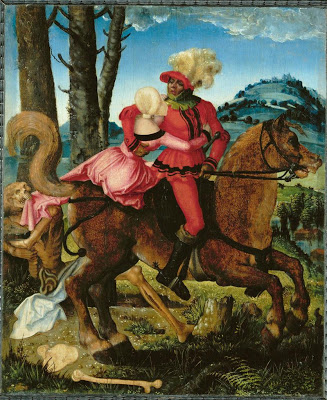Medieval History
 Well, that's certainly one way of being saved from the jaws of death...
Well, that's certainly one way of being saved from the jaws of death...
- The Staffordshire Hoard
Prof. Simon Keynes writes: 'The Staffordshire Hoard (or perhaps more accurately the 'Hammerwich Hoard', after the place where it was found) is certainly a very significant discovery, and represents a most welcome addition to our knowledge...
- More Pieces From The Staffordshire Hoard Discovered
The Staffordshire Hoard has now grown by a further 81 pieces, after a Coroner?s Court declared yesterday that the newly found objects were part of the Anglo-Saxon treasure. South Staffordshire Coroner Andrew Haigh ruled that 81 of the 91 pieces...
- Viking Gold Ring Found In Yorkshire Farm Field
A gold ring once worn by a Viking was unearthed by a metal detector in a farmer's field in Yorkshire, a treasure trove inquest in Wakefield heard yesterday. Dating back around 1,000 years, the large gold ring was found last April on pasture land in...
- Medieval News Of The Week
Kirkleatham Museum to display jewels from Cleveland grave of Anglo-Saxon princess Ancient skull unearthed on farm Fragment from world's oldest Bible found hidden in Egyptian monastery Skeleton revealed by excavation Video: Bodies found in a Peterborough...
- The Staffordshire Hoard Strikes Again
Outside of the United Kingdom, when you think 'hoards' in Britain, you would not be blamed for thinking of the bounteous Eighth Century Sutton Hoo Hoard in East Anglia with its stunning gold and silver helmet inlaid with garnets, elaborate brooches,...
Medieval History
A picture, some news, and more updates to come!
 Well, that's certainly one way of being saved from the jaws of death...
Well, that's certainly one way of being saved from the jaws of death...And in more exciting news:
So, on September twenty-fifth (yes, last month) an amateur treasure hunter (what this constitutes I do not know - maybe an old guy with a metal detector and a shovel like you find on the beach?) discovered an absolutely enormous horde of Anglo-Saxon gold and silver artefacts as he was rummaging through a farmer's field (doubtful the farmer gave him permission). This discovery has sent archaeologists, historians, curators and Medievalists alike abuzz the world over. Amongst the treasures found we have: a really pretty helmet crest with a frieze of wild animals running along the side; enamel studded sword fittings; a checkerboard piece with gold and garnet inlays (I wouldn't mind having a set of those!); and a gold band with a Latin biblical inscription that calls on God to drive away the bearer's enemies. Nifty! This cash of lovely artefacts was discovered in what was Mercia, one of the five major Anglo-Saxon kingdoms, and are thought to date between 675 and 725.
The fellow who found the cache says that it was "more fun that winning the lottery." Oh, I bet it was! "I was going to bed and in my sleep I was seeing gold items," he said after notifying the authorities after five days of searching this farmer's field.
Over eleven pounds of gold was found, which included weaponry, crosses, and a giant cross that may have been carried into battle, five long golden snakes, and a strip of gold with a crudely written and horribly misspelled Latin Biblical inscription ("Rise up, O Lord, and may thy enemies be dispersed and those who hate thee be driven from thy face" - Book of Numbers).
The treasure hunter and his farmer "friend" are up for seven figures of cash once the artefacts are sold to museums, apparently. Not bad as there could be as many as 1,500 items in the treasure horde.
One expert has gone so far as to liken this discovery to the discovery of King Tut's tomb. Interestingly enough, the giant processional/battle cross was folded before being buried.
In case you don't know (!!!) who the Anglo-Saxons were, they were a group of Germanic tribes who invaded England when the Romans left it, they made really, really pretty gold ornaments, and their language, Old English, is the great-great-great grandfather (or some such thing) of our beloved Modern English.
I hope you enjoyed this late update!
Sincerely,
Your Minister of Propaganda*
*How's this name? I like it. Do you like it? I like it.
Also, here's the link for the story on this update: http://dsc.discovery.com/news/2009/09/25/treasure-trove.html
- The Staffordshire Hoard
Prof. Simon Keynes writes: 'The Staffordshire Hoard (or perhaps more accurately the 'Hammerwich Hoard', after the place where it was found) is certainly a very significant discovery, and represents a most welcome addition to our knowledge...
- More Pieces From The Staffordshire Hoard Discovered
The Staffordshire Hoard has now grown by a further 81 pieces, after a Coroner?s Court declared yesterday that the newly found objects were part of the Anglo-Saxon treasure. South Staffordshire Coroner Andrew Haigh ruled that 81 of the 91 pieces...
- Viking Gold Ring Found In Yorkshire Farm Field
A gold ring once worn by a Viking was unearthed by a metal detector in a farmer's field in Yorkshire, a treasure trove inquest in Wakefield heard yesterday. Dating back around 1,000 years, the large gold ring was found last April on pasture land in...
- Medieval News Of The Week
Kirkleatham Museum to display jewels from Cleveland grave of Anglo-Saxon princess Ancient skull unearthed on farm Fragment from world's oldest Bible found hidden in Egyptian monastery Skeleton revealed by excavation Video: Bodies found in a Peterborough...
- The Staffordshire Hoard Strikes Again
Outside of the United Kingdom, when you think 'hoards' in Britain, you would not be blamed for thinking of the bounteous Eighth Century Sutton Hoo Hoard in East Anglia with its stunning gold and silver helmet inlaid with garnets, elaborate brooches,...
